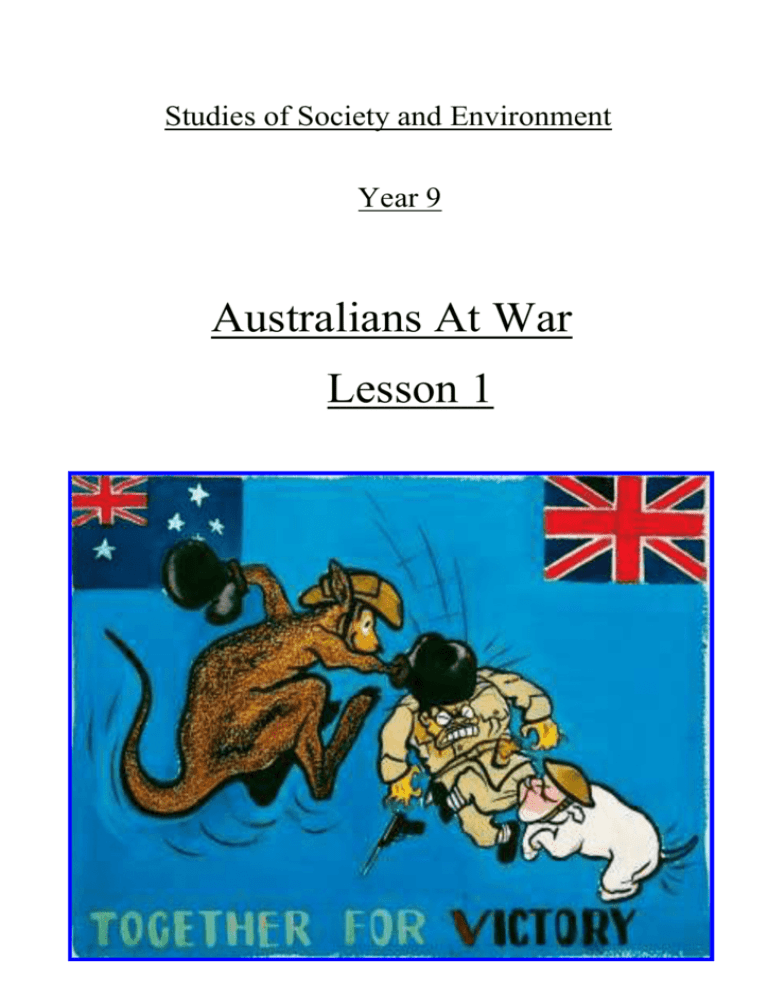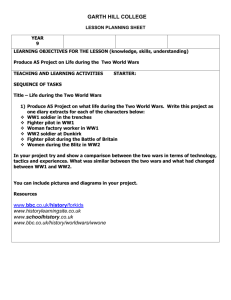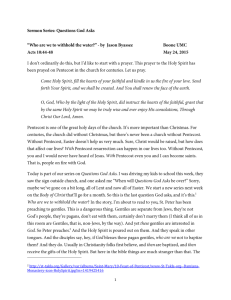lesson 1 images wiki
advertisement

Studies of Society and Environment Year 9 Australians At War Lesson 1 Student Booklet Name: ____________________ EXAMINE THE FOLLOWING IMAGES " Australian troops marching towards docks to board ships bound for the fighting during World War I. Location: Adelaide, Australia Date taken: November 14, 1914 Image taken from: http://images.google.com/hosted/life/l?imgurl=686523b869a02e11&q=WORLD%20WAR%20ONE%20AUSTRALIAN% 20SHIPS&prev=/images%3Fq%3DWORLD%2BWAR%2BONE%2BAUSTRALIAN%2BSHIPS%26ndsp%3D20%26hl%3D en%26rls%3Dcom.microsoft:en-US%26sa%3DN%26start%3D120%26um%3D1 Tank used in WW1 Image taken from: http://www.tanks4hire.co.uk/media/WW1.jpg Warehouse used as a temporary hospital WW1 Image taken from: http://www.anzacday.org.au/history/ww1/anecdotes/images/heliopolis2.jpg OBSERVATION TASK: Please look at the photos above and take note of the following: Notice the crowds of civilian’s that came to see the soldiers off during WW1. Look at the old design of the tanks used in WW1. Weapons technology is much more advanced today. Observe the numbers of causalities bedded in this make shift hospital during WW1. Think about how wars are fought today? What weapons do soldiers use? You are only required to look at the photos and think about the notes in this yellow box. Australian Soldiers at Gallipoli http://www.news.com.au/common/imagedata/0,,6003000,00.jpg Soldiers have just embarked at Gallipoli Source: http://upload.wikimedia.org/wikipedi a/commons/6/6f/Lancashire_Fusiliers _boat_Gallipoli_May_1915.jpg Plane crash landing at Eastern Front during WW 11 Source:http://images.google.com/imgres?imgurl=http://1.bp.blogspot.com/_9pO1Dfpv NqE/SRnFFgOvA2I/AAAAAAAAAXw/yvNYmRJ6UQ8/s400/944197_20080821_scr een007.jpg&imgrefurl=http://gns2.blogspot.com/2008/11/call-of-duty-5-world-at Tank used in WW 11 Source: http://www.battletanks.com/ima ges/M4_w_Flamethrower-1.jpg OBSERVATION TASK: Although many Australian soldiers fought in both World War 1 & World War 11 neither of these wars were fought on Australian soil. Think about why Australia sent troops overseas to fight and die in these wars Source: http://www.mobiriot.com/wp-content/uploads/2008/11/world_war_ii_2.jpg WW11 bomb Image taken from: http://www.london2012.com/blog/uploads/world-war-2-bomb.jpg WW 11 Death camps Source: http://i4.ytimg.com/vi/CjIJsBE9eqE/hqdefault.jpg This is an image of the cloud created by a nuclear bomb dropped during the Second World War. Bombs such as this are capable of killing millions of people and create wide spread destruction to civilization. Welcome to WW11 rations Source:http://www.ww2rationtechnologies.com/parakrat.jpg Australian soldiers voting at the conscription referendum, Belgium, 8 December 1917. Source: http://www.ww1westernfront.gov.au/messines/images/awme01605.jpg Korean war http://i4.ytimg.com/vi/CjIJsBE9eqE/hqdefault.jpg After math after invasion Sorce:http://media-2.web.britannica.com/eb-media/76/71376-004-E2A636B8.jpg Cows were introduced to Japan during the occupation to fed the soldiers and the refugees as the ecological system of the country was severely damaged. After Japan’s surrender the country was devastated economically and socially. Source: http://www.history.navy.mil/photos/images/g10000/g17489.jpg Source: http://www.wagyugenetics.com.au/images/what_are_wagyu.jpg Photo of Kim Phuc. June 8, 1972. The village of Trang Bang was bombed by a Napalm bomb during an aerial attack on suspected Viet Cong locations. This photo is probably one of the most recognisable war photos of all time. Source: http://images.google.com/imgres?imgurl=http://traveltovietnam.cc/Upload/tour/288200834634_Vietnam%2520War 11.jpg&imgrefurl=http://traveltovietnam.cc/Travel-Vietnam/Vietnam-Tour/Vietnam-History-Tours/29/VietnamWar-Tour-10-days Source: http://z.about.com/d/asianhistory/1/0/d/0/-//DongHaVietnam1966.jpg Vietnam war Source: http://msnbcmedia.msn.com/j/msnbc/Components/Newsweek/Ph otos/Web_Exclusives/040308_040314/040313_vietnamIraq_vl.wi dec.jpg Iraqi man welcomes U.S Troops. Source: jsoda.blogfodder.net/ archives/2003_04.ht Australian veterans in Korean war Source: http://cache.daylife.com/imageserve/0dLi8947Zz3Sk/340x.jpg U.S Soldiers in Kuwait. Gulf War 1990-1991 Source: PBS Frontline: \http://www.pbs.org/wgbh/pages/frontline/gulf/war/ Observation Task: From the above pictures we can see that soldiers make many sacrifices for their country. Therefore soldiers who fight in wars to protect their country are heroes. The general public supports their efforts and gives them a heroes welcome when they return home. Soldiers have to do what they are told for the better good of mankind. Think about if you agree with these comments then look at the next set of photos. PUBLIC OPINION CHANGES ANTI WAR PROTESTS 1. Washington DC Anti-war protests (Vietnam War) 2 - San Francisco (Iraq War) 3 - Sydney (Iraq War) Source Pictures 1, 2 & 3: eyewitnessonhistory.com Observation Task: The photos show that people’s opinions about wars can change. Think about how you would feel if you were a soldier fighting in such a war. Imagine some one you loved was killed in one of the wars in which the public opinion changed. You are only required to think about this issue. If you want you can follow the link to learn more changing opinions about these wars. What is War? A War is when two sides fight against each other. This often includes large battles where soldiers from each side fight. At one time the soldiers fighting would have used hand held weapons. More recently weapons have been invented that can fire bullets and bombs a long way. This has changed the way that wars are fought. Wars in the modern age can affect millions of people. In the Twentieth Century there were two World Wars. Each of these wars led to the deaths of millions of people. Millions of other people were made homeless and many others suffered from wounds or hunger. Listed below are terms used regarding wars: War Conflict Battle Soldier Civilian Devastation Surrender Conscription Rations Observation Task: Look at the pictures above showing war and see if you can identify a picture that represents each of the above words. Activity 1. lesson 1 Fill out the worksheet that is provided at the link. This task requires that you provide dictionary definitions for the above list of words. Fill out the work sheet and email to me. Work sheet can be found at this link. ..\enhanced learning environment lesson 2\lesson 1 worksheet activity 1 dictionary definitions what is war.doc Did your understanding of the word match to the dictionary definition? TIME LINE OF WARS THAT AUSTRALIA HAS FOUGHT IN THE 20TH CENTURY. Australians at War - Timeline First World War 1914-1918 Second World War 1939-1945 Korean War 1950-1953 Malayan Emergency 1950-1960 Confrontation (Indonesia) 1964-1966 Vietnam War 1962-1972 Gulf War (Middle East) 1990-1991 Peacekeeping - Indonesia 1947-1951 Iraq 2003 – Present Observation task: As s you can see Australia has fought in many wars this century but none of the above wars were fought on Australian soil. This list is just meant to show you that Australia has been militarily active. In future lessons we will look at each of these wars in some more detail. Activity 2 Please complete work sheet and evaluation questions. Access the work sheet through the link. ..\enhanced learning environment lesson 2\lesson 1 what is war word search work sheet 1.doc After completeing the work sheet email it to me at carer@spitfire.com.au Activity 3 You may need to referr to the time line and the word definitions to complete Work Sheet 3. Please complete work sheet and return to me via my email address. ..\enhanced learning environment lesson 2\work sheet lesson 1 activity 3 assess what we've learn't about war.doc





